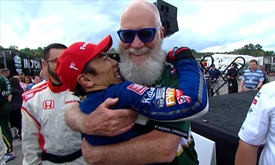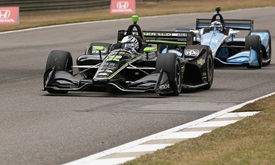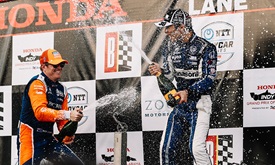There's something magical about a Sato win
APR 09, 2019
Not long after Takuma Sato’s victory Sunday in the Honda Indy Grand Prix of Alabama, Japanese journalist Hiro Matsumoto posted on social media a photo of the lucky numbers from a fortune cookie he opened Friday in Birmingham. Among the numbers were 30, 18, 5, 9 and 10.
If you’re scoring at home, those numbers correspond to the cars of Sato, Sebastien Bourdais, James Hinchcliffe, Scott Dixon and Felix Rosenqvist. Or the entire podium, along with sixth and 10th place.
More evidence of the magic of Takuma Sato.
If you’re curious about the importance of Sato in his home country, do an internet search regarding his media coverage in Japan. You’ll spend hours seeing how he’s presented, perceived and revered. You’ll also realize just how famous he is. He’s been a sports star in his homeland since he first strapped into a Formula One car in 2002, but since winning the Indianapolis 500 in 2017, he’s reached a level of fame no INDYCAR driver can dream of attaining stateside.
Much of that fame can be traced to the writers and photographers who relay Sato's accomplishments back to Japan. After a rollicking victory lane presentation following Sato’s victory Sunday at Barber Motorsports Park, a photo emerged of Japanese photographer Kazuki Saito lying on his side, getting just the right artful shot from ground level.
It appears one of our Japanese #IndyCar photographers was a bit overcome by the emotions of @TakumaSatoRacer’s win @BarberMotorPark .... or he was being artistic. Could go either way. 🤣 #HIGPA pic.twitter.com/xbord9u9r6
— Pat Caporali (@PCaporali) April 7, 2019
As he does at every race, Sato held a separate press conference with Japanese journalists after winning. Matsumoto, Saito and others track Sato’s every lap for readers and viewers in Japan. He isn’t just a subject, he’s their friend. He doesn’t just accommodate their coverage, he embraces it.
The same goes for fans from his homeland. Long before the win at Indy, they traveled to the U.S. to see Sato race. But since then, it’s an even more common occurrence. And when they visit, they get to meet him, and they don’t meet him without bringing gifts.
“Generally speaking, Japanese fans get very majestic and royal about racing,” Sato said last year. “I’ve seen so many fans fly over from Japan to the States just to see a race just for the weekend. They have to request a day off from work before they leave and the Monday after the race to travel back. That’s a great deal of commitment. It’s not cheap, either, but they come.
“Some of the fans will come four or five times during the year. That’s unbelievable. Every time they come, they bring some kind of gift or snacks. That doesn’t just happen because I won the Indy 500. This has been happening for seven or eight years, but the number has increased this year. I can’t tell you how much I appreciate it.”
Sato sat down last year – at Barber, coincidentally – to be the feature of a three-part series on IndyCar.com. He covered a wide range of topics, one of which being fame. And with fame comes great modesty.
“The Japanese fans have known me for a long time, and they haven’t seen anything change, really,” he said then. “But a lot of people who didn’t know much about me now recognize me as an Indy 500 champion. I get a lot more great support from fans. That’s one significant thing that has happened.”
Sato’s motto – no attack, no chance – fits him perfectly. He attacks relentlessly because, without the attack, there is no chance. It’s his trademark, and it worked Sunday at Barber in his No. 30 Mi-Jack/Panasonic Honda for Rahal Letterman Lanigan Racing.
“Coming to this weekend, my team says, ‘We want to come here to plan to dominate,’” Sato said Sunday. “Of course, we wanted to be competitive, but after seeing a couple of road-course tests and the race at COTA, we thought we could be maybe top five, but we never expected to be front row (in qualifying with teammate Graham Rahal), which is fantastic. This is motor racing. This is the science behind it, but this is also a magical feeling, as well, and that's what I learned this weekend.”
He attacked, which led to the chance, which led to victory. If we’re lucky, it will continue to happen for a long time. Because there’s nothing as magical as a Takuma Sato victory.



















